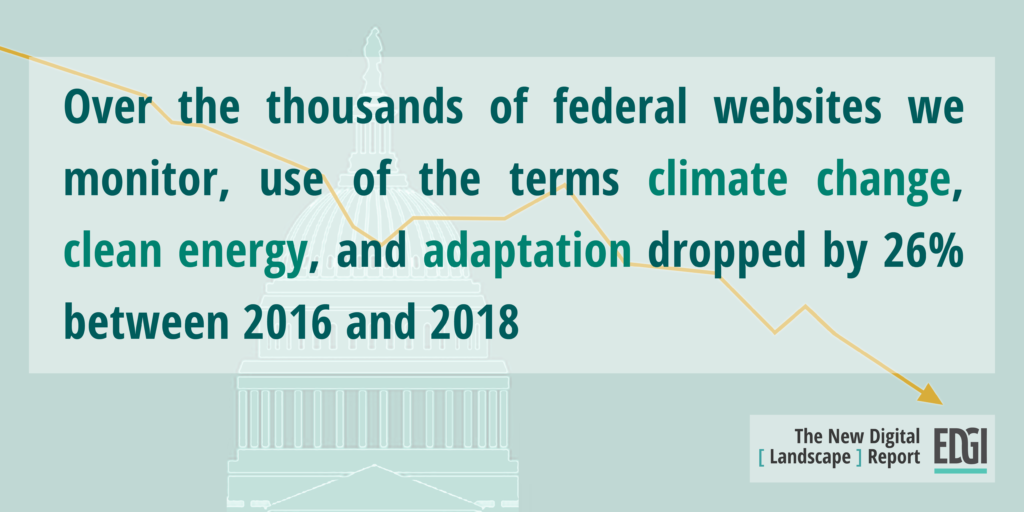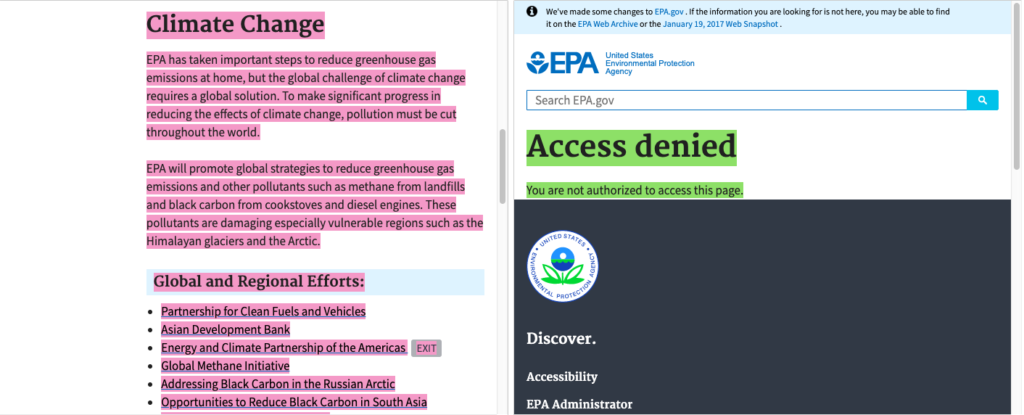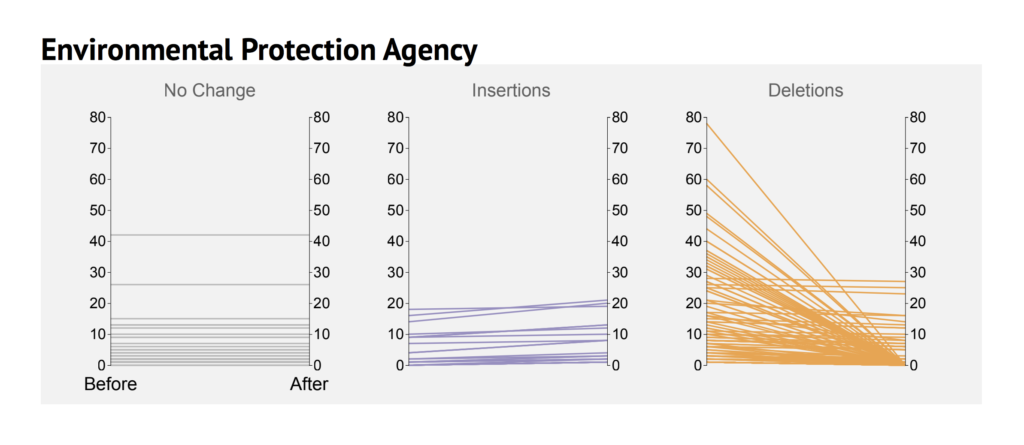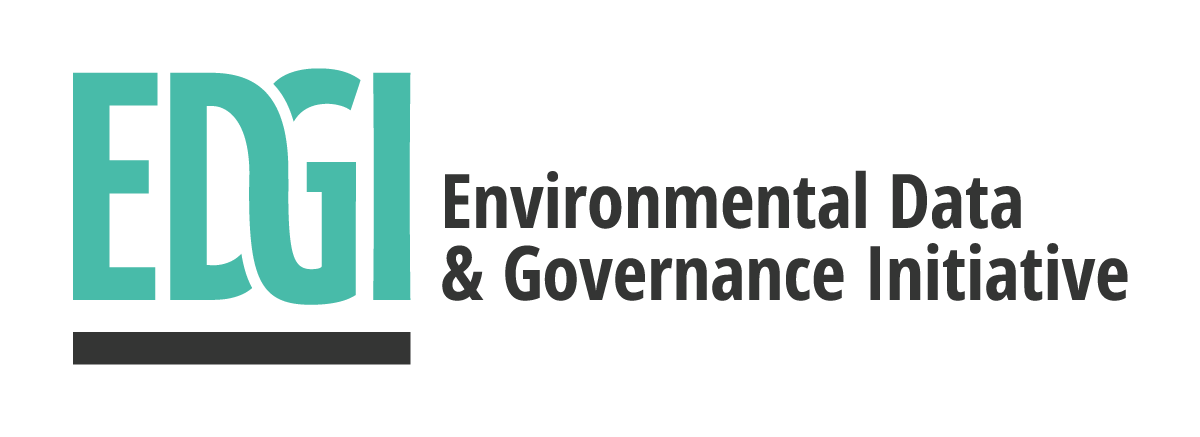Authors: Eric Nost, Gretchen Gehrke, Aaron Lemelin, Marcy Beck, Steven Braun, Garance Malivel, and EDGI

In EDGI’s latest report, “The New Digital Landscape,” we build on our existing research to analyze how the Trump administration has altered access to climate change information on federal environmental websites and the language used to present it. Over the thousands of websites we monitor, we find:
- the use of the terms “climate change,” “clean energy,” and “adaptation” dropped by 26% between 2016 and 2018
- catch-all terms that are employed to undermine clear analysis – such as “energy independence,” “resilience,” and “sustainability” – increased by 26%
- Over half of all pages where “climate change” was completely removed from public access (73 / 136) were U.S. Environmental Protection Agency (EPA) pages. Such removals are significant given that EPA.gov was the 1,750th most visited website in the U.S. in early 2019, giving it more reach than even WhiteHouse.gov. 1
U.S. federal government websites are a key component of an infrastructure that supports environmental awareness and decision-making. The website changes we document actively erode the digital “bridge” by which publicly-funded research is contextualized and shared with those in need of information, including the general public and decision-makers in state, local, and tribal governments. Rather than cultivating the informational resources necessary to confront climate change, the Trump administration has attempted to remove the topic from federal agency websites, a clear policy indicator in line with withdrawing from the Paris Agreement and revoking the Clean Power Plan. While prominent political, journalistic, and scientific entities are sharpening the language they use to describe the climate crisis, we see precisely the opposite from this administration: removal of the term ”climate change” and its replacement with less clear language.

From the report: EPA removed access to the “International Priorities” page in December 2017. The page had included two introductory paragraphs that discussed “shared environmental and governance challenges” in EPA’s bilateral and multilateral partnerships, including challenges like global climate change.
In the report, we classify website changes made by the administration into three types:
- Undermining climate change as a key component of pressing policy challenges – such as when the Occupational Safety and Health Administration (OSHA) removed all references to “climate change” on a page dealing with how workers and employers can manage heat-related health risks on the job.
- Changing descriptions of science and scientists – such as when the Environmental Protection Agency (EPA) recategorized the work of some of its researchers from “Climate Science” to categories like “Ecosystems”.
- Removing access to and descriptions of resources – such as the Department of Transportation’s (DOT) Climate Change Clearinghouse, which was removed from climate.dot.gov, later restored elsewhere, and largely removed again.
While our research cannot make definitive conclusions about motivation in all cases, changes to sites may often be the result of direct politicization – that is, orders from senior administration officials and political appointees. Indeed, right-wing climate denial groups with privileged access to the EPA – such as The Heartland Institute – have submitted reports directly to the White House identifying climate-related webpages for the administration to remove. In other cases, there may be indirect self-censorship occurring, in which agency or program staff modify climate change content to “fly under the radar” of politically-appointed higher-ups. 2

Despite the Trump administration’s anti-science agenda, many climate resources are still available. Our research spotlights some of these, including:
- EPA’s ARC-X adaptation resource center, Greenhouse Gas Reporting Program, and Climate Research and Climate Indicators pages.
- NASA, NOAA, and USDA climate hubs (climate.gov, climate.nasa.gov, climatehubs.oce.usda.gov).
- The 2018 interagency National Climate Assessment.
However, not all of these accessible resources are well-maintained. For instance, EPA’s Climate Indicators site has not been refreshed since 2016, even though the data itself for the indicators presented on the site – such as average surface temperatures – has been updated by NOAA each year since. 3
Moreover, we see resistance from within the administration to its anti-science approach. This takes place on social media and the web more generally. For instance, agency staffers adopted “rogue” or “alt” social media accounts to dispute higher-ups without fear of retribution. We also document several cases where web managers at the EPA have updated broken links. These links pointed to removed content, and managers redirected them to accessible, archived versions of the content.
We conclude our report with three recommendations to not only mitigate the harm done by the Trump administration, but also to build a more just federal web infrastructure around climate change information:
- Restore – to counter removals of critical information, restore it.
- Revamp – transparently update and maintain pages with the latest science.
- Rethink – pursue environmental data justice. EDJ is about making sure data are accessible to, controlled by, and relevant to communities. 4 Several of the removals and page edits we document in the report unduly affect marginalized populations (e.g. workers, the elderly, and Spanish-language speakers). Web resources must be legible and relevant to all.
